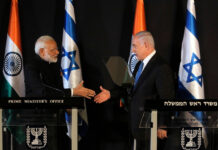The Iranian parliament voted last sunday to unite the presidential elections with the upcoming parliamentary ones, this according to the official Iranian news agency. The proposal, which passed with a surprising 80 percent majority, may cut the term of President Mahmoud Ahmadinejad by 18 months. The bill must still be ratified by the Iranian constitutional committee, which is headed by former president Akbar Hashemi Rafsanjani, Ahmadinejad’s arch-rival, a fact which many see as indicative that the bill will indeed be authorized. Parliament approved a draft bill upon which the parliamentary and presidential elections would be held simultaneously in the first quarter of 2008.
Although Iran’s parliament is dominated by the ultraconservative Abadgaran (Development) Party of which the president is a senior member, there is already growing disconcerting evidence among the religious clerics to Ahmadinejad’s messianic rhetoric. In a sign of divisions at the top of the clerical establishment, even the supreme leader, Ayatollah Ali Khamenei, who has until now supported Mr Ahmadinejad, said “irregularities” in the government’s behaviour would not be tolerated. Older, traditionalist conservatives, are worried that Ahmadinejad is trying to instigate a new Iranian revolution this time within the existing structure of the state. They fear he wants to bring younger extremists from the Revolutionary Guard into top positions of power, ousting the older clerics who have previously held sway and embarking on a new cultural revolution that could unsettle their rule.
Still, the hard-line president has a strong power base, backed by his own spiritual adviser, Ayatollah Taqi Mesbah-Yazdi, who recently suggested that future elections were superfluous because a true Islamic government had arisen. But the most remarkable aspect of Mr Ahmadinejad’s piety is his insinuation to the “Hidden Imam”, or Mahdi, the Messiah-like figure of Shia Islam. The 49-year-old Mr Ahmadinejad, who was surprisingly elected over his arch rival Akbar Hashemi Rafsanjani, sees his main mission, as he recounted in a speech in Tehran, as to “pave the path for the glorious reappearance of Imam Mahdi, may Allah hasten his reappearance.” According to Shiites, the 12th imam disappeared as a child in the year 941. When he returns, they believe, he will reign on earth for seven years, before bringing about a final judgment and the end of the world. According to his adversaries in the clerical establishment, Ahmadinejad’s messianic obsession crossed the line where the domestic audience is concerned is, when he said a “green aura was coming out of his head” during his speech to the United Nations. As result, the main rift is no longer between “reformists” and “hardliners”, but between the clerical establishment and Mr Ahmadinejad’s brand of revolutionary populism and superstition. Iranian President Mahmoud’s Ahmadinejad’s mystical pre-occupation with the coming of a Shiite Islamic messiah figure – the Mahdi.
Hashemi Rafsanjani himself is still considered one of the most powerful politicians in Iran and is currently running for a position in the Assembly of Experts, an 86-strong body of ayatollahs who monitor the Iranian Supreme Leader (a position currently held by Ayatollah Ali Khamenei). The Assembly has the power to dismiss the Supreme Leader. Already existing tensions have heightened between Ahmadinejad and Rafsanjani as the latter is pitted directly against Ahmadinejad’s spiritual mentor Masbah Yazdi who is also vying for a spot on the Assembly of Experts.
Even below surface all is not well in Mahmoud Ahmadinejad’s tenure. Major opposition is already being reported from the pragmatist camp in Iran, who despite their belief that Iran has a right to obtain nuclear energy for civilian use, feel that the Ahmadinejad camp is not being flexible enough in its dealings with the European Union. This camp, headed by Ayatollahs Rafsanjani and Karrubi, has also expressed major concern regarding Iran’s economic capability to effectively withstand economic sanctions. However, Iran’s economic wellbeing aside, Ayatollah Rafsanjani most notably stands to lose millions of dollars worth of business if the West imposes economic sanctions on Iran, as Rafsanjani-owned companies are heavily involved in international trade. It is also reported that Rafsanjani has numerous international investments, stretching from Thailand to Canada.
A little known event, which happened last January, proved most concerting to the president, when Rafsanjani met secretly with Iran’s supreme leader and old revolutionary comrade Ayatollah Khamenei. It is a known fact that Khamenei has already tried to reduce his former protege’s influence by giving Rafsanjani senior political positions such as the presidency of the Expediency Council. Furthermore, during that same month, Rafsanjani went on a trip to the heart of Iran’s religious establishment in the city of Qom, where he met 11 of Iran’s 14 grand ayatollahs. This is a clear sign that Rafsanjani is looking for consensus for a major policy change.
Not only his political status may be jeopardised by the upcoming elections. There is also much more violent unrest in store. On Dec. 15, 2005 gunmen ambushed Ahmadinejad’s motorcade, was attacked on the Zabol- Saravan highway in Baluchistan where Sunni Baluchis have been fighting for autonomy from Iran’s Shiite theocratic government. Similar incidents happened in other Arab Shiite provinces, such as oil rich Kuzestan, one of the most strategic regions of Iran, bordering with Arab Shiite southern Iraq.
















